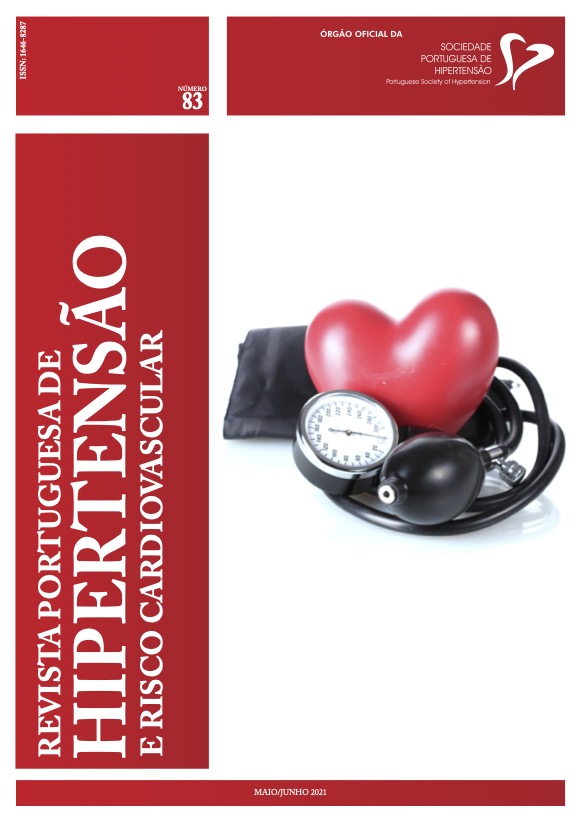SECONDARY ARTERIAL HYPERTENSION: A CASE REPORT OF FIBROMUSCULAR DYSPLASIA
DOI:
https://doi.org/10.58043/rphrc.28Abstract
Fibromuscular dysplasia (FMD) is an idiopathic, non-inflammatory, non-atherosclerotic systemic disease characterized by stenosis, occlusion, aneurysm, dissection and tortuosity of arterial beds. Arterial hypertension (HTN) is the most common manifestation of FMD of renal arteries.
This article describes a clinical case suggestive of FMD as cause of secondary hypertension – a 47-year-old woman with long-term and difficult-to-control HTN, with multiple end-organ damage and history of acute kidney injury associated with the introduction of Valsartan; analytically, the patient had increased plasma aldosterone/renin ratio (32.5:1) and imagiologically reduction of the caliber of renal arteries and celiac trunk, ischemia of the left kidney and aneurysms of the pancreatic-duodenal, lumbar and cerebral arteries was observed.
The diagnosis of FMD is based on clinical evaluation and imaging tests (renal arteriography is the gold-standard, but non-invasive tests are considered reasonable alternatives). Treatment includes medical therapy, and revascularization (angioplasty or surgery) may be considered if the benefits outweigh the risks of the procedure.
Downloads
References
Olin JW, Froehlich J, Gu X, Bacharach JM, Eagle K, Gray BH et al. The United States Registry for Fibromuscular Dysplasia: results in the first 447 patients. Circulation. 2012;125(25):3182
Gornik HL, Persu A, Adlam D, Aparicio LS, Azizi M, Boulanger M et al. First International Consensus on the diagnosis and management of fibromuscular dysplasia. Vasc Med. 2019;24(2):164
Rooke TW, Hirsch AT, Misra S, Sidawy AN, Beckman JA, Findeiss LK et al. 2011 ACCF/AHA Focused Update of the Guideline for the Management of Patients With Peripheral Artery Disease (updating the 2005 guideline): a report of the American College of Cardiology Foundation/American Heart Association Task Force on Practice Guidelines. J Am Coll Cardiol. 2011;58(19):2020.
Slovut DP, Olin JW. Fibromuscular dysplasia. N Engl J Med. 2004;350(18):1862.
Hirsch AT, Haskal ZJ, Hertzer NR, Bakal CW, Creager MA, Halperin JL et al. ACC/AHA 2005 Practice Guidelines for the management of patients with peripheral arterial disease (lower extremity, renal, mesenteric, and abdominal aortic): a collaborative report from the American Association for Vascular Surgery/Society for Vascular Surgery,Society for Cardiovascular Angiography and Interventions, Society for Vascular Medicine and Biology, Society of Interventional Radiology, and the ACC/ AHA Task Force on Practice Guidelines (Writing Committee to Develop Guidelines for the Management of Patients With Peripheral Arterial Disease): endorsed by the American Association of Cardiovascular and Pulmonary Rehabilitation; National Heart, Lung, and Blood Institute; Society for Vascular Nursing; TransAtlantic Inter-Society Consensus; and Vascular Disease Foundation. Circulation. 2006;113(11):e463.
Trinquart L, Mounier-Vehier C, Sapoval M, Gagnon N, Plouin PF. Efficacy of revascularization for renal artery stenosis caused by fibromuscular dysplasia: a systematic review and meta- analysis. Hypertension. 2010;56(3):525.
Downloads
Published
How to Cite
Issue
Section
License
Copyright (c) 2022 Revista Portuguesa de Hipertensão e Risco Cardiovascular

This work is licensed under a Creative Commons Attribution 4.0 International License.




